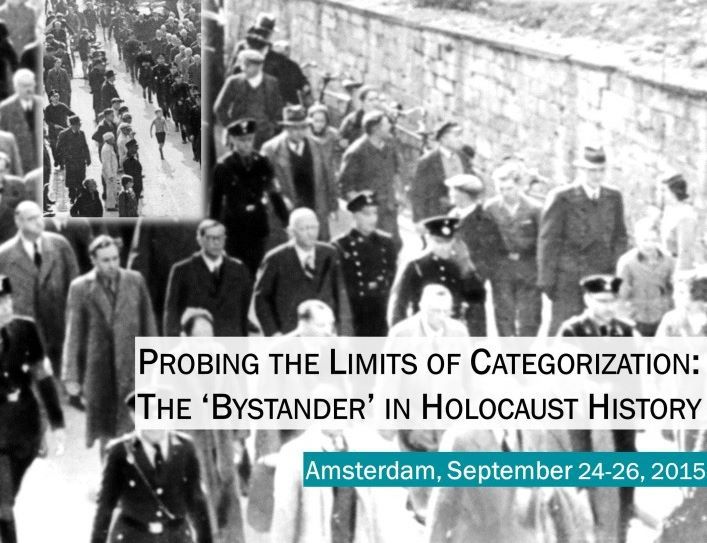The 'Bystander' in Holocaust History
International Conference
Probing the Limits of Categorization: The “Bystander” in Holocaust History
Amsterdam, Sept. 24-26, 2015
Among the three categories used to analyze the role of individuals in the Holocaust, the ‘bystander’ is the broadest and vaguest. According to, Raul Hilberg, who coined the term, it refers to all those who were ‘once a part of this history.’ Generations of Holocaust scholars have used Hilberg’s triangulation or variations thereof to analyze, systematize and narrate the wealth of historical experiences under Nazi rule. Whereas it seems relatively easy to define who belonged to the category of perpetrator and victim, analyzing the thoughts and actions of the other contemporaries remains a challenging task for international historiography.
The aim of the conference is thus to thoroughly review and to think beyond the existing scholarly approaches to the stereotypical ‘bystander’ in Holocaust history. It is intended to encourage the formulation of innovative concepts, which might enable historians to consider hitherto overlooked or marginalized aspects of historical reality or to view familiar processes from entirely new angles. The keynote will be given by Mary Fulbrook (London) and speakers will include Frank Bajohr (Munich), Jan Grabowski (Ottawa/Warsaw), Tatjana Tönsmeyer (Wuppertal/Essen), Ido de Haan (Utrecht) and Jacques Sémelin (Paris). Bringing together scholars of Jewish and non-Jewish populations in Nazi Germany and German-occupied territories across Europe, ten systematically structured panels will address the following themes:
Concept History: Genesis of an Elusive Category
The “Bystander” avant la lettre: Categorizations and Narrations in the Postwar Years
Social Dynamics I: Societal Processes of Exclusion and Disintegration
Social Dynamics II: Interactions and Relations in Local Communities
Depictions: Visual Evidence of and by Bystanders
Reflections: The Bystander through the Victim’s Eyes during and after the Holocaust
Attitudes and Agency: Shades of Bystanding Behavior
Cultures of Violence: Presence, Participation, Incrimination
Representations: Bystanders in Film and Museum
Adaptions: In Search of New Categories
Please note that there is a limited number of places available. You can register by sending an e-mail to aanmeldingen-dia@uva.nl (subject: Bystander conference). Registration is possible until the 7th of September 2015. Please note that registration does not guarantee a place. Preference will be given to applicants with a stated academic interest in the subject. We will inform you after September 7 if you are on the participant list. For further information, please contact the organizers at: bystander-dia@uva.nl.
Institutional partners and financial support:
Duitsland Instituut Amsterdam (DIA); IfZ Center for Holocaust Studies, Munich; NIOD, Amsterdam; Jena Center 20th Century History; Deutsch-Polnische Wissenschaftsstiftung Frankfurt/Oder; Thyssen Foundation; DAAD

